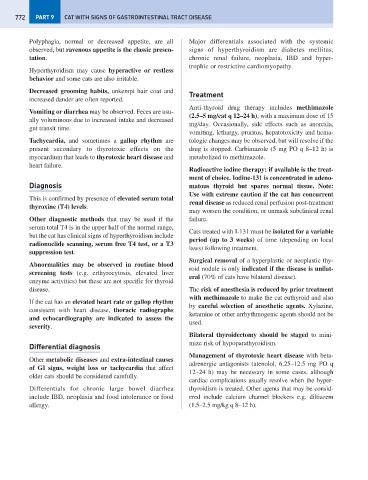Page 780 - Problem-Based Feline Medicine
P. 780
772 PART 9 CAT WITH SIGNS OF GASTROINTESTINAL TRACT DISEASE
Polyphagia, normal or decreased appetite, are all Major differentials associated with the systemic
observed, but ravenous appetite is the classic presen- signs of hyperthyroidism are diabetes mellitus,
tation. chronic renal failure, neoplasia, IBD and hyper-
trophic or restrictive cardiomyopathy.
Hyperthyroidism may cause hyperactive or restless
behavior and some cats are also irritable.
Decreased grooming habits, unkempt hair coat and
Treatment
increased dander are often reported.
Anti-thyroid drug therapy includes methimazole
Vomiting or diarrhea may be observed. Feces are usu-
(2.5–5 mg/cat q 12–24 h), with a maximum dose of 15
ally voluminous due to increased intake and decreased
mg/day. Occasionally, side effects such as anorexia,
gut transit time.
vomiting, lethargy, pruritus, hepatotoxicity and hema-
Tachycardia, and sometimes a gallop rhythm are tologic changes may be observed, but will resolve if the
present secondary to thyrotoxic effects on the drug is stopped. Carbimazole (5 mg PO q 8–12 h) is
myocardium that leads to thyrotoxic heart disease and metabolized to methimazole.
heart failure.
Radioactive iodine therapy: if available is the treat-
ment of choice. Iodine-131 is concentrated in adeno-
Diagnosis matous thyroid but spares normal tissue. Note:
Use with extreme caution if the cat has concurrent
This is confirmed by presence of elevated serum total
renal disease as reduced renal perfusion post-treatment
thyroxine (T4) levels.
may worsen the condition, or unmask subclinical renal
Other diagnostic methods that may be used if the failure.
serum total T4 is in the upper half of the normal range,
Cats treated with I-131 must be isolated for a variable
but the cat has clinical signs of hyperthyroidism include
period (up to 3 weeks) of time (depending on local
radionuclide scanning, serum free T4 test, or a T3
laws) following treatment.
suppression test.
Surgical removal of a hyperplastic or neoplastic thy-
Abnormalities may be observed in routine blood
roid nodule is only indicated if the disease is unilat-
screening tests (e.g. erthyrocytosis, elevated liver
eral (70% of cats have bilateral disease).
enzyme activities) but these are not specific for thyroid
disease. The risk of anesthesia is reduced by prior treatment
with methimazole to make the cat euthyroid and also
If the cat has an elevated heart rate or gallop rhythm
by careful selection of anesthetic agents. Xylazine,
consistent with heart disease, thoracic radiographs
ketamine or other arrhythmogenic agents should not be
and echocardiography are indicated to assess the
used.
severity.
Bilateral thyroidectomy should be staged to mini-
mize risk of hypoparathyroidism.
Differential diagnosis
Management of thyrotoxic heart disease with beta-
Other metabolic diseases and extra-intestinal causes
adrenergic antagonists (atenolol, 6.25–12.5 mg PO q
of GI signs, weight loss or tachycardia that affect
12–24 h) may be necessary in some cases, although
older cats should be considered carefully.
cardiac complications usually resolve when the hyper-
Differentials for chronic large bowel diarrhea thyroidism is treated. Other agents that may be consid-
include IBD, neoplasia and food intolerance or food ered include calcium channel blockers e.g. diltiazem
allergy. (1.5–2.5 mg/kg q 8–12 h).

